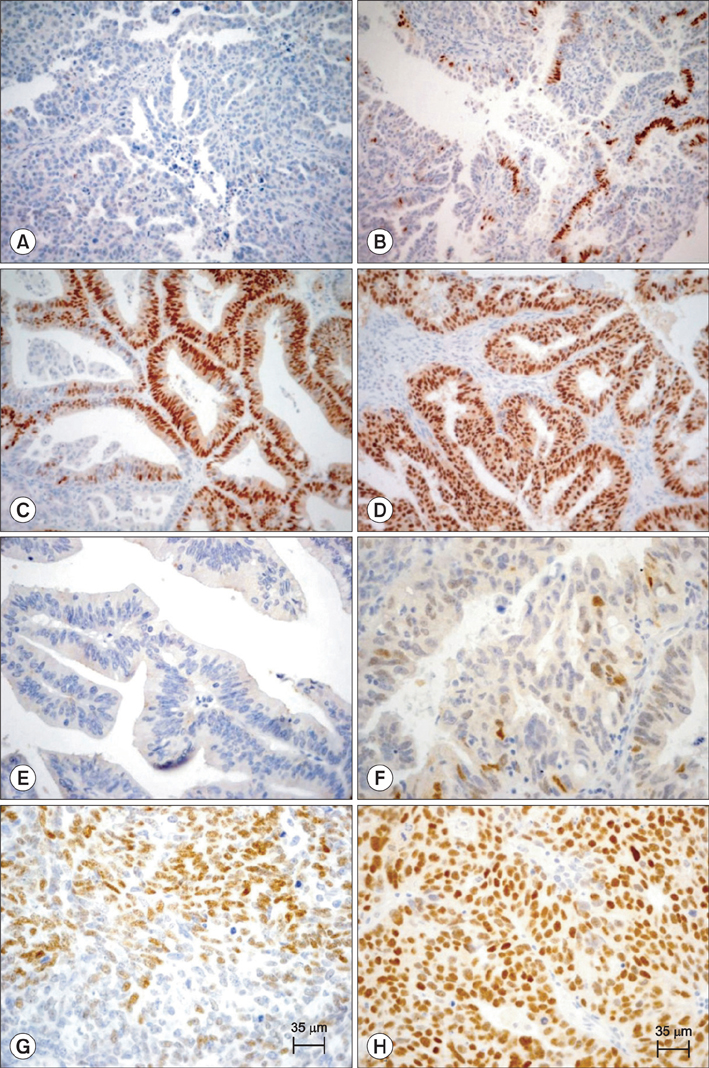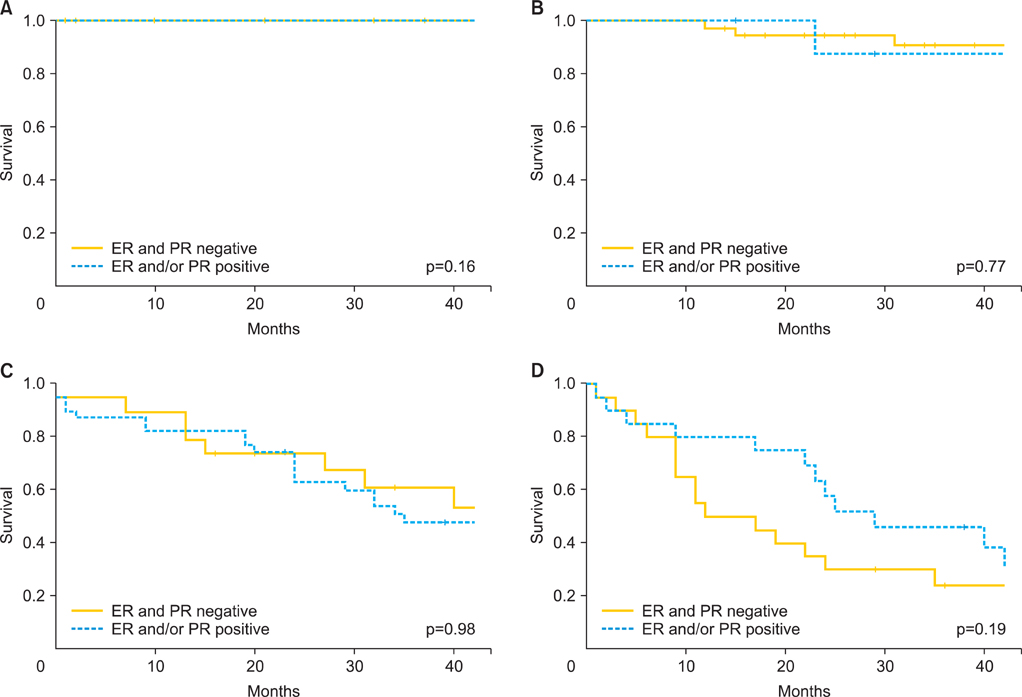J Gynecol Oncol.
2013 Apr;24(2):167-176. 10.3802/jgo.2013.24.2.167.
Survival of women with ovarian carcinomas and borderline tumors is not affected by estrogen and progesterone receptor status
- Affiliations
-
- 1Department of Obstetrics and Gynecology, Faculty of Medical Sciences, State University of Campinas-UNICAMP, Sao Paulo, Brazil. sophie.derchain@pq.cnpq.br
- 2Department of Pathology, Faculty of Medical Sciences, State University of Campinas-UNICAMP, Sao Paulo, Brazil.
- 3Department of Pathology, Laboratory of Investigative and Molecular Pathology, CIPED, State University of Campinas-UNICAMP, Campinas, Sao Paulo, Brazil.
- 4Department of Pathology, Hospital do Cancer A C Camargo, Fundacao Antonio Prudente de Sao Paulo, Sao Paulo, Brazil.
- 5Laboratory of Experimental Pathology, CAISM, State University of Campinas-UNICAMP, Sao Paulo, Brazil.
- 6Faculty of Medical Sciences, State University of Campinas-UNICAMP, Sao Paulo, Brazil.
- KMID: 2288549
- DOI: http://doi.org/10.3802/jgo.2013.24.2.167
Abstract
OBJECTIVE
To examine the patterns of estrogen receptor (ER) and progesterone receptor (PR) expression in borderline ovarian tumors (BOTs) and ovarian carcinomas. We also assessed the disease-free survival (DFS) and overall survival (OS) in women with ovarian carcinoma, in relation to ER and/or PR expression.
METHODS
We examined ER/PR expression in 38 BOTs and 172 ovarian carcinomas removed from patients treated at the State University of Campinas-UNICAMP (Brazil), from 1993 to 2008 and followed for up to 60 months using tissue microarray-based immunohistochemistry.
RESULTS
Twenty-eight (73.7%) mucinous and 10 (26.3%) serous BOTs were included. Ovarian carcinomas consisted mainly of 79 (46.0%) serous, 44 (25.5%) mucinous, 17 (9.8%) endometrioid, 10 (5.8%) clear-cell types. There was no significant difference of the ER/PR expression between BOT and ovarian carcinoma (p=0.55 for ER alone, 0.90 for PR alone, and 0.12 for combined expression). The level of ER/PR expression in BOTs was significantly higher in serous than in mucinous tumors (p<0.01). In carcinomas, ER/PR was higher in serous tumors than in mucinous (p<0.01) and clear cell tumors (p=0.02), and higher in endometrioid tumors than in mucinous tumors (p<0.01). DFS was affected neither by the clinical characteristics nor by combined steroid receptor status. OS was found to be significantly worse (p<0.01) only in women with stages II-IV tumors and those with residual disease after surgery (p<0.01).
CONCLUSION
Overall, serous and endometrioid tumors were predominantly ER/PR positive, whereas mucinous and clear-cell tumors were preponderantly ER/PR negative. DFS and OS were not affected by ER/PR expression.
Keyword
MeSH Terms
Figure
Reference
-
1. Yang XY, Xi MR, Yang KX, Yu H. Prognostic value of estrogen receptor and progesterone receptor status in young Chinese ovarian carcinoma patients. Gynecol Oncol. 2009. 113:99–104.2. Tangjitgamol S, Manusirivithaya S, Khunnarong J, Jesadapatarakul S, Tanwanich S. Expressions of estrogen and progesterone receptors in epithelial ovarian cancer: a clinicopathologic study. Int J Gynecol Cancer. 2009. 19:620–627.3. Hogdall EV, Christensen L, Hogdall CK, Blaakaer J, Gayther S, Jacobs IJ, et al. Prognostic value of estrogen receptor and progesterone receptor tumor expression in Danish ovarian cancer patients: from the 'MALOVA' ovarian cancer study. Oncol Rep. 2007. 18:1051–1059.4. Lindgren PR, Cajander S, Backstrom T, Gustafsson JA, Makela S, Olofsson JI. Estrogen and progesterone receptors in ovarian epithelial tumors. Mol Cell Endocrinol. 2004. 221:97–104.5. Arias-Pulido H, Smith HO, Joste NE, Bocklage T, Qualls CR, Chavez A, et al. Estrogen and progesterone receptor status and outcome in epithelial ovarian cancers and low malignant potential tumors. Gynecol Oncol. 2009. 114:480–485.6. Iversen OE, Skaarland E, Utaaker E. Steroid receptor content in human ovarian tumors: survival of patients with ovarian carcinoma related to steroid receptor content. Gynecol Oncol. 1986. 23:65–76.7. Geisler JP, Wiemann MC, Miller GA, Geisler HE. Estrogen and progesterone receptor status as prognostic indicators in patients with optimally cytoreduced stage IIIc serous cystadenocarcinoma of the ovary. Gynecol Oncol. 1996. 60:424–427.8. Lee P, Rosen DG, Zhu C, Silva EG, Liu J. Expression of progesterone receptor is a favorable prognostic marker in ovarian cancer. Gynecol Oncol. 2005. 96:671–677.9. Kommoss F, Pfisterer J, Thome M, Schafer W, Sauerbrei W, Pfleiderer A. Steroid receptors in ovarian carcinoma: immunohistochemical determination may lead to new aspects. Gynecol Oncol. 1992. 47:317–322.10. Munstedt K, Steen J, Knauf AG, Buch T, von Georgi R, Franke FE. Steroid hormone receptors and long term survival in invasive ovarian cancer. Cancer. 2000. 89:1783–1791.11. Bizzi A, Codegoni AM, Landoni F, Marelli G, Marsoni S, Spina AM, et al. Steroid receptors in epithelial ovarian carcinoma: relation to clinical parameters and survival. Cancer Res. 1988. 48:6222–6226.12. Slotman BJ, Nauta JJ, Rao BR. Survival of patients with ovarian cancer. Apart from stage and grade, tumor progesterone receptor content is a prognostic indicator. Cancer. 1990. 66:740–744.13. Harding M, Cowan S, Hole D, Cassidy L, Kitchener H, Davis J, et al. Estrogen and progesterone receptors in ovarian cancer. Cancer. 1990. 65:486–491.14. Sevelda P, Denison U, Schemper M, Spona J, Vavra N, Salzer H. Oestrogen and progesterone receptor content as a prognostic factor in advanced epithelial ovarian carcinoma. Br J Obstet Gynaecol. 1990. 97:706–712.15. Hempling RE, Piver MS, Eltabbakh GH, Recio FO. Progesterone receptor status is a significant prognostic variable of progression-free survival in advanced epithelial ovarian cancer. Am J Clin Oncol. 1998. 21:447–451.16. Schwartz PE, MacLusky N, Merino MJ, Livolsi VA, Kohorn EI, Eisenfeld A. Are cytosol estrogen and progestin receptors of prognostic significance in the management of epithelial ovarian cancers? Obstet Gynecol. 1986. 68:751–758.17. Anderl P, Fuith LC, Daxenbichler G, Marth C, Dapunt O. Correlation between steroid hormone receptors, histological and clinical parameters in ovarian carcinoma. Gynecol Obstet Invest. 1988. 25:135–140.18. Rose PG, Reale FR, Longcope C, Hunter RE. Prognostic significance of estrogen and progesterone receptors in epithelial ovarian cancer. Obstet Gynecol. 1990. 76:258–263.19. Masood S, Heitmann J, Nuss RC, Benrubi GI. Clinical correlation of hormone receptor status in epithelial ovarian cancer. Gynecol Oncol. 1989. 34:57–60.20. Benedet JL, Bender H, Jones H 3rd, Ngan HY, Pecorelli S. FIGO staging classifications and clinical practice guidelines in the management of gynecologic cancers. FIGO Committee on Gynecologic Oncology. Int J Gynaecol Obstet. 2000. 70:209–262.21. Serov SF, Scully RE, Sobin LH. International histological classification and staging of tumors: histologic typing of ovarian tumors. 1973. Geneva: World Health Organization.22. Rosen DG, Huang X, Deavers MT, Malpica A, Silva EG, Liu J. Validation of tissue microarray technology in ovarian carcinoma. Mod Pathol. 2004. 17:790–797.23. Akahira J, Suzuki T, Ito K, Kaneko C, Darnel AD, Moriya T, et al. Differential expression of progesterone receptor isoforms A and B in the normal ovary, and in benign, borderline, and malignant ovarian tumors. Jpn J Cancer Res. 2002. 93:807–815.24. R: Development Core Team. R: a language and environment for statistical computing. 2004. Vienna: R Foundation for Statistical Computing.25. Ho SM. Estrogen, progesterone and epithelial ovarian cancer. Reprod Biol Endocrinol. 2003. 1:73.
- Full Text Links
- Actions
-
Cited
- CITED
-
- Close
- Share
- Similar articles
-
- Expression of E-cadherin in Benign, Borderline, and Malignant Ovarian Epithelial Tumors
- Expression and biologic significance of human estrogen receptor-alpha and -beta, progesterone receptor A and B, androgen receptor in benign, borderline, and malignant epithelial ovarian tumors
- Estrogen and Progesterone receptors in Meningioma
- Survival Benefit of Tamoxifen in Estrogen Receptor-Negative and Progesterone Receptor-Positive Low Grade Breast Cancer Patients
- The expression of clusterin, bax, p53, Ki-67, and apoptotic index in epithelial ovarian tumors



